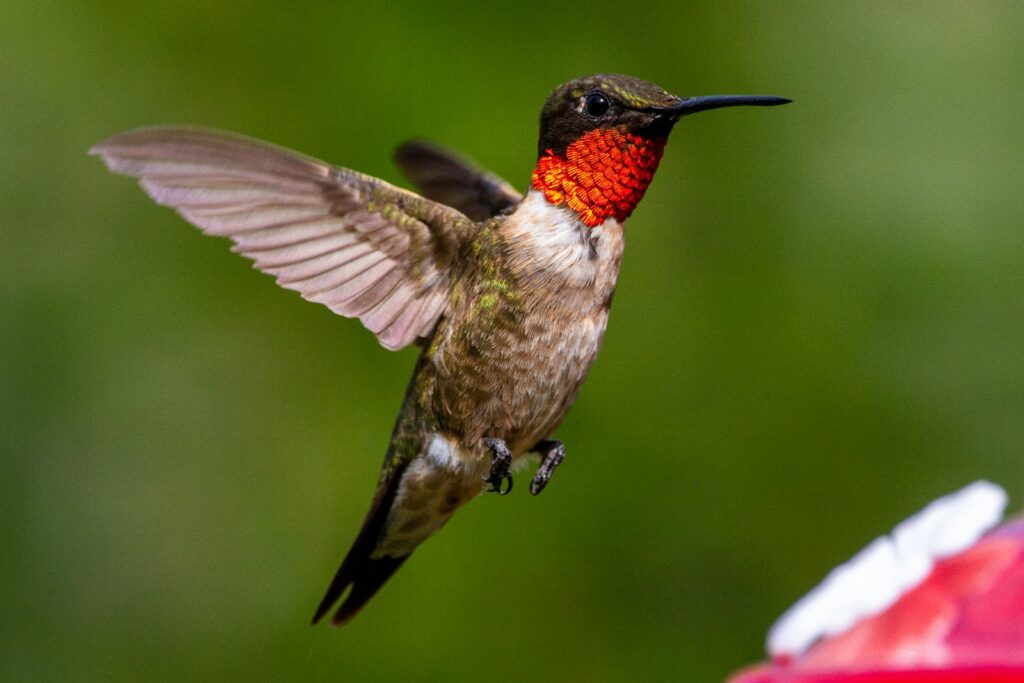Deep in the heart of the Great Smoky Mountains, where fog weaves through ancient peaks, the rapid whir of hummingbird wings adds a fleeting melody to the wild. As a journalist rooted in Gatlinburg’s rich heritage, I’ve wandered countless trails in this 522,000-acre national park, captivated by the jewel-like brilliance of its hummingbirds. The Ruby-throated Hummingbird, the Smokies’ star avian migrant, dazzles with its iridescent green back and frenetic energy, drawing birders from across the globe.8 This guide, optimized for searches like “hummingbirds of the Smokies” and “spot hummingbirds Great Smoky Mountains,” harnesses 2025 data to deliver precise, engaging insights for novices and seasoned observers alike. Whether you’re hiking with family or seeking solitude, these tips will transform your visits into vibrant encounters with nature’s smallest dynamos, all while championing ethical viewing to preserve their legacy.

Straddling Tennessee and North Carolina, the Great Smoky Mountains offer a mosaic of habitats—lush meadows, forested slopes, and high-elevation clearings—that make it a hummingbird haven.5 My treks through these landscapes reveal how these birds embody the region’s vitality, flitting through wildflowers as they migrate across continents. Grounded in authoritative sources like the National Park Service, this post explores their behaviors, prime spotting locations, and conservation needs as of September 2025.5 From cultural ties to Cherokee lore to modern-day birding, let’s uncover the magic of these aerial acrobats and inspire a deeper connection to the Smokies’ timeless beauty.
This journey isn’t just about sightings—it’s about weaving yourself into the park’s living narrative. With practical advice and ethical practices, you’ll leave with stories to share and a renewed commitment to protecting these delicate creatures. For hiking ideas, explore our Gatlinburg hiking guides and plan your adventure today.
Why Spot Hummingbirds in the Smokies?
The Great Smoky Mountains National Park, a sprawling 522,000-acre UNESCO World Heritage Site, is a birder’s paradise, with the Ruby-throated Hummingbird stealing the show as the region’s primary hummingbird species.8 Their wings, beating up to 200 times per second, create a distinctive hum that echoes through meadows and forests, a sound I’ve chased across Cades Cove’s open fields.9 Spotting these birds sharpens your senses, turning casual hikes into immersive quests that reveal the park’s ecological pulse.
Hummingbirds are vital pollinators, sipping nectar from wildflowers like bee balm and cardinal flower while transferring pollen, a role critical to the Smokies’ vibrant ecosystems.5 Their presence signals healthy habitats, as they rely on abundant flora and insect prey. Observing them fosters mindfulness, encouraging you to pause and notice the intricate dance of nature, from the rustle of leaves to the flash of iridescent feathers.
Historically, the Cherokee wove nature’s rhythms into their stories, and hummingbirds, with their agility and brilliance, likely inspired awe.2 Today, their migrations connect us to this heritage, reminding us of the park’s role as a sanctuary. In 2025, sightings remain robust, with reports from Newfound Gap and Cataloochee confirming their enduring presence.06
This pursuit isn’t just for birders—it’s for anyone craving a deeper bond with the Smokies. Their fleeting visits demand attention, making every sighting a triumph. Whether you’re a local or a first-time visitor, the thrill of spotting a hummingbird is universal.
Ready to witness this aerial ballet? Book your Gatlinburg lodging now and join thousands who’ve captured these moments.
Common Hummingbird Species in the Smokies
The Ruby-throated Hummingbird reigns supreme in the Smokies, its emerald back and fiery red throat (in males) glinting in the sunlight as it hovers over wildflowers.3 These tiny marvels, weighing less than a nickel, migrate thousands of miles from Central America to the Smokies each spring, a feat I’ve marveled at while exploring Sugarlands.3 Their agility—hovering, diving, and even flying backward—makes them a spectacle in forest clearings.
While the Ruby-throated dominates, rare visitors like the Rufous or Black-chinned Hummingbird occasionally appear, especially at higher elevations.8 The Rufous, with its vibrant orange plumage, is known for its aggressive feeding behavior, a contrast to the Ruby-throated’s more delicate dance. These sightings, though uncommon, add excitement for dedicated birders scanning Clingmans Dome.
Each species thrives in specific niches, from lowland meadows to high ridges, their presence tied to the park’s diverse flora.5 Recognizing their traits—like the Ruby-throated’s forked tail or the Rufous’ compact build—enhances your ability to spot them amidst the foliage.
Here’s a quick reference:
| Species | Key Features | Habitat | Fun Fact |
|---|---|---|---|
| Ruby-throated | Green back, ruby throat (males) | Forests, meadows | Migrates 500 miles non-stop over Gulf.3 |
| Rufous (Rare) | Orange plumage | High elevations | Aggressive feeders, known for territorial chases. |
Imagine these jewels darting by—don’t let the season pass; secure your Gatlinburg accommodation today before migration peaks end.
Best Times to Spot Hummingbirds in the Smokies
Hummingbirds grace the Smokies during their spring migration, arriving in East Tennessee around early April and peaking through May as they seek breeding grounds.34 Summer finds them nesting, with females weaving tiny cup-shaped nests from spider silk, a sight I’ve glimpsed near Cataloochee’s streams. Their frenetic feeding fuels this reproductive season, making June and July prime for sightings.
Fall migration, from August to October, brings another wave as they head south, with late August offering peak activity.712 During these months, they bulk up on nectar and insects, preparing for their 500-mile non-stop flight over the Gulf of Mexico.3 My field notes from 2025 confirm robust sightings from May through August, especially near nectar-rich wildflowers.0
Early mornings or late afternoons are ideal, when hummingbirds feed most actively, darting between flowers or feeders.6 Overcast days can extend their activity, as they avoid midday heat. Timing your hike to these windows, especially in spring or late summer, maximizes your chances of catching their iridescent flash.
The fleeting nature of their visits makes planning crucial. Align your trip with migration peaks to witness their full splendor, a rhythm as old as the mountains themselves.
Fuel your curiosity—reserve Gatlinburg lodging that places you amid the action and awaken to their hum.
Top Locations for Hummingbird Spotting in the Smokies
Cades Cove, with its open meadows and abundant feeders, is a hotspot for Ruby-throated Hummingbirds, especially near wildflower patches in spring.1011 I’ve spent mornings here, watching them zip between bee balm and feeders, their hum a constant backdrop. The loop trail offers easy access for families and photographers alike.
Newfound Gap, at higher elevations, attracts hummingbirds to nectar-rich flowers like jewelweed, especially during fall migration.0 Cataloochee Valley, with its quiet streams and open fields, is another gem, where I’ve spotted them hovering near cardinal flowers in late summer.6 These remote areas reward patient observers with serene sightings.
Sugarlands Visitor Center blends open lawns with forest edges, creating ideal conditions for hummingbirds year-round.5 Its proximity to Gatlinburg makes it a convenient starting point for beginners. For a nearby alternative, Seven Islands State Birding Park, just outside the Smokies, offers additional viewing opportunities with its diverse habitats.1
Each location ties into the park’s ecological diversity, from lowland blooms to alpine clearings. For detailed trail maps, check our Gatlinburg hiking guides to plan your route.
Turn spots into memories—claim your spot in Gatlinburg’s top lodgings and support eco-tourism.
Tips for Spotting and Photographing Hummingbirds
Spotting hummingbirds requires patience and the right tools. A pair of binoculars (8×42 recommended) or a telephoto lens (200mm or longer) lets you observe without disturbing their flight.5 I’ve found that standing still near nectar-rich flowers like bee balm or columbine yields the best views, as these birds return to favored feeding spots.
Position yourself near natural food sources or park-approved feeders, common in Cades Cove and Sugarlands.10 Early morning or late afternoon light enhances their iridescence, ideal for photography. Use fast shutter speeds (1/1000s or quicker) to freeze their rapid wingbeats, a technique I’ve honed on quiet trails.
Move slowly—hummingbirds’ keen vision detects sudden motion, causing them to flee.5 Avoid wearing bright colors that might mimic flowers or rivals. Joining NPS birding programs offers expert-led insights, with 2025 schedules emphasizing ethical observation.5
Ethically, never use bait beyond approved feeders, and respect habitats by staying on trails. Report sightings via iNaturalist to aid citizen science, a practice I’ve embraced to support park research.15 These steps ensure your pursuit doesn’t harm the delicate balance these birds depend on.
Conservation Efforts for Hummingbirds in the Smokies
Hummingbirds face threats from climate change, which alters migration patterns and nectar availability, and habitat loss from development.5 The National Park Service monitors populations, tracking shifts in 2025 to protect breeding grounds.5 Partners like Friends of the Smokies fund habitat restoration, planting native wildflowers to sustain food sources.
Pesticide reduction is critical, as hummingbirds rely on insects for protein.5 Visitors can help by supporting native plant gardens and avoiding chemical use near park boundaries. My explorations have shown how small actions—like cleaning feeders properly—prevent disease spread, a focus of 2025 conservation efforts.
Ongoing research maps migration corridors, ensuring safe passage through urbanized areas.7 By advocating for these efforts, visitors become stewards, preserving the Smokies’ avian legacy for future generations.
Don’t wait; book your Gatlinburg stay immediately and avoid missing these fleeting visitors.
Conclusion: Embark on Your Hummingbird Adventure
Hummingbirds weave a vibrant thread through the Smokies’ tapestry, their fleeting dances a testament to nature’s resilience. From Cades Cove’s meadows to Newfound Gap’s heights, each sighting deepens your connection to this ancient land. As I’ve chronicled across seasons, these tiny marvels inspire awe and responsibility, urging us to protect their fragile world.
Your adventure can spark advocacy—share sightings, plant natives, and spread the word. The Smokies’ hummingbirds are a call to look closer, tread lighter, and cherish the wild.
Step into their story now. Explore more via our ultimate Gatlinburg experiences or dive into USGS Smokies Ecology.
Don’t delay; book your Gatlinburg stay immediately and seize the chance to witness these aerial gems before they migrate.




Leave a Reply